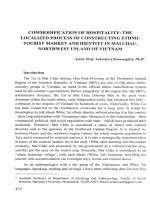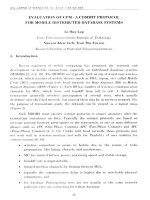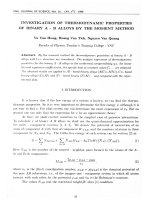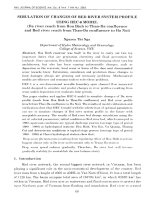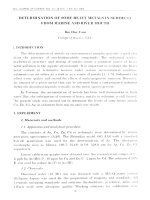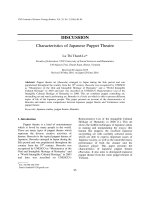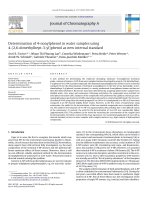DSpace at VNU: Cloning of some heat shock proteins genes for further transcriptional study of Planktothrix agardhii exposed to abiotic stress
Bạn đang xem bản rút gọn của tài liệu. Xem và tải ngay bản đầy đủ của tài liệu tại đây (363.49 KB, 7 trang )
Folia Microbiol
DOI 10.1007/s12223-014-0372-9
Cloning of some heat shock proteins genes for further
transcriptional study of Planktothrix agardhii exposed to abiotic
stress
Chi Thi Du Tran & Cécile Bernard & Katia Comte
Received: 24 August 2014 / Accepted: 15 December 2014
# Institute of Microbiology, Academy of Sciences of the Czech Republic, v.v.i. 2014
Abstract Planktothrix agardhii is one of the freshwater
cyanobacteria that can produce the hepatotoxin microcystins
(MC)—a real threat to human and animal health. Knowledge
of the biological role of MC in producing organisms is highly
desired to understand the driving force of MC production.
Recently, emerging evidences have suggested that MC may
have protective role in cells facing environmental stress. If this
is true, one should expect differences in the cellular protective
mechanisms between MC-containing and MC-deficient mutant strains. To test this hypothesis, it would be essential to
investigate the consequences of the loss of MC in Planktothrix
in the transcriptional responses of its heat shock proteins
(Hsps) to abiotic stresses—an important component of cellular stress response. However, a crucial first step is prerequisite
for the isolation of hsp genes here, as the genome of
Planktothrix has not been fully published. Therefore, we have
successfully isolated four hsp genes including clpC (hsp100),
htpG (hsp90), groEL (hsp60), and groES (hsp10) from
Planktothrix agardhii PCC 7805 using ramped annealing
PCR (RAN-PCR) with consensus-degenerate hybrid oligonucleotide primers (CODEHOP) and annealing control primer
(ACP) system. In addition, some putative regulatory sequences found in the upstream region of groESL operon of
Planktothrix agardhii were also discussed.
C. T. D. Tran
Faculty of Biology, Hanoi University of Science, VNU-Hanoi,
Hanoi, Vietnam
C. T. D. Tran : C. Bernard : K. Comte (*)
UMR 7245 CNRS-MNHN “Molécules de Communication et
Adaptation des Micro-organismes”, Muséum National d’Histoire
Naturelle, 12 rue Buffon CP 39, 57 rue Cuvier, 75231 Paris Cedex
05, France
e-mail:
Introduction
Organisms, during their lifetime, have to face various environmental fluctuations. In order to maintain cellular homeostasis, they have to be able to constantly sense and trigger the
protective mechanisms including the modulation of the expression of stress proteins to adapt to environmental changes.
Amongst these stress proteins, heat shock proteins (Hsps) play
an important role in protein folding, assembly, translocation,
and degradation in many normal cellular processes, stabilize
proteins and membrane, and can assist in protein refolding
under stress conditions (Wang et al. 2004). Although Hsps are
constitutively expressed, they are also induced in cells exposed to stressful conditions (Stephanou et al. 2011).
The cyanobacteria (photosynthetic prokaryotes) have an impressive ability to adapt to the environment that allow them to
colonize almost all ecological niches including extreme conditions like hot spring or snow (Whitton and Potts 2000). Some
species frequently found in temperate zone such as Planktothrix
agardhii (Gomont) (Anagnostidis and Komarek 1988) can produce different variants of microcystins (MC). Actually, the MC
have been isolated from multiple cyanobacterial genera including Microcystis, Anabaena, Planktothrix, Oscillatoria,
Chroococcus, and Nostoc (Pearson et al. 2010; Sivonen and
Jones 1999). Amongst them, Planktothrix is one of the most
prevalent nuisance species with highest concentration of MC per
biomass unit (Fastner et al. 1999; Scheffer et al. 1997). Although
the effects of MC on growth and physiological functions of
various other organisms have been well studied, their function
for the producing organisms still remains obscure despite its
importance in understanding the driving forces of the production
of toxin (Babica et al. 2006). Recently, there are increasing
numbers of facts that indicate an intracellular function of MC
related to environmental stresses especially when an oxidative
stress occurred (Briand et al. 2008; Dziallas and Grossart 2011;
Neilan et al. 2013; Zilliges et al. 2011). In the complex
Folia Microbiol
response of cyanobacteria to abiotic stress, the activities
of Hsps play important roles. Cyanobacteria produce
different types of Hsps upon exposure to stress
(Bergmann et al. 2010; Tran et al. 2013; Webb et al.
1990; Webb and Sherman 1994). The five main classes
of Hsps are discovered to be present in cyanobacteria
(Wase et al. 2013). The protective effects of Hsps can
be attributed to the network of the chaperone machinery
(Wang et al. 2004). If MC have protective role in cells
facing stressful stimuli, we speculate that the expression
of genes coding for Hsps might be different in an MCproducing strain and its MC-deficient mutant. To test
this hypothesis, the expressions of hsp genes of an MCproducing strain and its MC-deficient mutant over different periods of exposure to abiotic stress, such as high
light stress (Tran et al. 2013), can be compared using
reverse transcription quantitative PCR (RT-qPCR).
However, prior to investigating such a stress response
analysis, a first step in the isolation of hsp genes (i.e.,
gene of interest (GOI)) is prerequisite, as the genome of
Planktothrix agardhii has not been fully sequenced yet.
We have obtained some sequences of hsp genes from
the genome project Genopole of Pasteur institute of
Paris (Tran TDC, PhD thesis, 2012). In order to have
representative genes of every main group of hsps, we
have isolated in this present study four hsp genes including clp (hsp100), htpG (hsp 90), groEL (hsp60),
and groES (hsp10).
The isolation of an unknown gene is always based on
the known sequences of its homologs from the other
(closely or distantly related) organisms. The procedure
usually comprises two steps: (1) amplification of a fragment of target sequence using appropriate primers and (2)
determination of uncharacterized DNA sequences
flanking the fragment obtained in the first steps (genome
walking). Consequently, our strategy consisted in the use
of a modified version of touchdown PCR: the ramped
annealing PCR (RAN-PCR) with a highly effective procedure in identification of unknown genes, the consensusdegenerate hybrid oligonucleotide primers (CODEHOP)
performed with the annealing control primer (ACP)
system.
Materials and methods
DNA template
Genomic DNA was extracted from the axenic strain of
Planktothrix agardhii PCC 7805 using Qiagen Dneasy
Blood & and Tissue kit. The protocol was modified to adapt
to Planktothrix agardhii (Tran TDC PhD thesis, 2012).
CODEHOP primers
The maximum known cyanobacterial protein sequences of each
Hsp were retrieved from NCBI Protein Database. These sequences were aligned using ClustalW multiple alignment program. These Clustal alignments were uploaded as input to
iCODEHOP ( Amongst the potential primers proposed by
iCODEHOP, for each gene, one pair of primers with lowest
degeneracy and a relatively long amplicon was selected for
PCR. Primers were synthesized by Eurogentec (Liège Science
Park, Belgium).
RAN-PCR and PCR product sequencing
Ramped annealing PCR (RAN-PCR) was used to amplify gene
fragments using CODEHOP primers. The thermal cycling program includes a preliminary denaturation step at 94 °C for
2 min, followed by 35 cycles of (94 °C for 20 s, 65 °C for
20 s, 60 °C for 5 s, 55 °C for 5 s, 50 °C for 5 s, 45 °C for 15 s,
68 °C for 1 min), and a final extension at 68 °C for 10 min.
RAN-PCR was performed in 50-μL total volume of reaction
containing 60 mmol Tris-SO4, pH 8.9, 18 mmol ammonium
sulfate, 2 mmol MgSO4, 0.2 mmol each dNTP, 0.4 μmol each
primer, 20 ng genomic DNA, 1 U Platinum Taq DNA polymerase High Fidelity (Invitrogen). The products were checked on
1.5 % (w/v) agarose gels (Dutscher Scientific). PCR products
were excised and purified from agarose gel by QIAquick Gel
Extraction Kit (QIAGEN Inc. USA).
Purified PCR products were then TA-cloned into pGEM-T
Easy vector (Promega, WI, USA) and transformed into
Escherichia coli JM109 competent cells (Promega, WI, USA).
After overnight incubation, the white colonies were picked, and
colony PCR was conducted using M13 universal primers. The
positive clones were sequenced by Genoscreen (Lille, France).
Sequences were compared with the database in GenBank using
Blastx programs.
Genome walking
DNA Walking SpeedUp Kit (Seegene Inc. Seoul, South
Korea) was used to determine the full-length genes. The kit
was developed from ACP technology (Hwang et al. 2003).
The procedure consists of three consecutive PCR using ACP
primers supplied with the kit and target-specific primers (TSP)
designed based on the sequences acquired in the previous
stage. For each upstream or downstream region to be determined, three TSPs must be designed. In fact, nested PCR is
incorporated in the procedure to enhance the specificity.
PCR products were processed, cloned, and sequenced as
previously described.
Folia Microbiol
The nucleotide sequences data reported in this study are
available in the DDBJ-EMBL-GenBank database under the
following accession numbers: KF275115 for the clpC gene,
KF275116 for the htpG gene, KF275119 for the groES, and
KF275121 for the groEL gene.
Results and discussion
Cloning of partial sequences by RAN-PCR using CODEHOP
primers
There are two strategies that have been used in designing
primers for unknown target: degenerate and consensus
primers (Boyce et al. 2009). Consensus primer has advantages
in the isolation of highly conserved gene homologs, but it is
very likely to fail in application to distantly related sequences
(Rose et al. 1998). As compared with consensus primer, the
use of degenerate primer enhances the possibility of including
a primer with exact complementary to an unknown target
DNA sequence. However, the degeneracy increases to accommodate more divergent genes, and the actual concentration of
an exact match primer drops. This results in a weak or undetectable band on a gel. Meanwhile, the degeneracy of primers
often complicates the selection of suitable annealing temperatures. CODEHOP strategy overcomes shortcomings of both
degenerate and consensus methods. As CODEHOP primers
comprise a relatively short degenerate 3′ core and a 5′ nondegenerate clamp, therein, the 3′ core degenerate is designed
from only highly conserved 3–4 amino acid, and the total
number of individual primers in the degenerate pool is minimized (Rose et al. 1998). Indeed, most of CODEHOP primers
acquired in this study had a degeneracy less than or equal to
32. GroES-F was the only primer whose degeneracy was
higher than 32 (64) (Table 1).
Amplification of Planktothrix agardhii PCC 7805 genomic
DNA with CODEHOP primers for each target gene using
RAN-PCR yielded one or several bands (data not shown).
For each gene, the band(s) closest to the predicted size
(Table 1) were TA-cloned and subsequently sequenced. The
matched gene fragments were confirmed by BLAST analysis.
For clp, htpG, groEL, and groES, we have obtained gene
fragments of 603, 749, 913, and 150 bp, respectively
(Table 2).
Determination of flanking regions of target genes by DNA
walking
For the success of RT-qPCR, the primers should be carefully
designed to satisfy stringent criteria. Therefore, a full-length
sequence would provide the best chance for primer selection.
Moreover, full-length sequence also allows a better identification of the gene. For each blanking region to be determined, after
three consecutive PCRs, the longest sharp products of the third
PCR were purified, TA-cloned, and subsequently sequenced.
The whole nucleotide sequence of each target gene was obtained
by analyzing the overlapping regions of the sequences isolated
by CODEHOP primers and their flanking sequences determined
by genome walking. The full-length sizes of the target genes are
presented in Table 2.
BLAST analyses showed that the obtained gene sequences
had high identity with the known genes from other
cyanobacteria. The highest identities between the deduced amino acid sequences of the putative genes isolated from
Planktothrix agardhii and their homologs from other
cyanobacteria were higher or equal to 82 % (Table 3).
Sequence analysis
Table 1
List of CODEHOP primers used in this study
Primer
name
Primer sequence (5′→3′)
Clp-F
CCCGGCGGACCAARAA
YAAYCC
Clp-R
GCCTCGTCCATCAGGT
CDATNGCYTT
GroEL- GACGTGGCCGGCGAYG
F
GNACNAC
GroEL- GGTCTCGGTGGCGGCN
R
CCNACYTT
GroES- CCCGACACCG
F
CCMRNGARAARCC
GroES- CAGCTTGATGTCGGTG
R
CCNGCRTAYTT
HtpG-F CAGATCCACACCGAGA
AYATHTTYCC
HtpG-R TGCAGGTTGTAGGGGT
ARTCNGTRTT
Degeneracy Predicted size of
amplicon (bp)
8
629
Putative Clp The full-length gene is of 2478 bp. The translated
product consists of 825 amino acids. The best match obtained
from a local alignment search within nonredundant protein
database (blastp) was with an ATP-dependent Clp protease
regulatory subunit of Lyngbya sp. PCC 8106 (93 % identity).
24
32
922
32
64
Table 2 Gene fragment sizes determined by PCR using CODEHOP
primers and the flanking regions determined by DNA walking
Gene
name
Gene fragment isolated Flanking region size
Full-length
by CODEHOP primers (bp)
gene size
(bp)
(bp)
Upstream Downstream
Clp
HtpG
GroEL
GroES
603
749
913
150
151
16
12
16
753
586
27
242
105
1289
1204
483
57
2478
1980
1638
312
Folia Microbiol
Table 3
Summary of the best hit against non-redundant protein database for the genes isolated in the study
No Gene (NCBI
accession)
Length of translated product
(amino acid)
Best hit against non-redundant protein database (NCBI Description/
accession)
function
Identity
(%)
1
2
3
4
825
659
543
103
Lyngbya sp. PCC 8106 (ZP_01620901.1)
Arthrospira sp. PCC 8005 (ZP_09780364.1)
Lyngbya sp. PCC 8106 (ZP_01624122.1)
Arthrospira sp. PCC 8005 (ZP_09784331.1)
93
82
91
89
clpC (KF275115)
htpG (KF275116)
groEL (KF275121)
groES (KF275119)
The sequence contains two well-conserved ATP-binding site
motifs that are separated by spacer sequence that is characteristic
of relatively large ATPase subunit of Hsp100 system (ClpA to
ClpD) (Gottesman et al. 1990; Schirmer et al. 1996).
In Synechococcus sp. PCC 7942, two clpB genes (clpBI and
clpBII) (Eriksson and Clarke 1996; Eriksson et al. 2001) and one
clpC gene (Clarke and Eriksson 1996) have been cloned and
characterized. Aligning the deduced amino acid sequence of the
putative clp gene of Planktothrix agardhii isolated in this study
with the amino acid sequences of ClpBI, ClpBII, and ClpC of
Synechococcus elongatus PCC 7942 revealed that this
Planktothrix Clp was most similar to ClpC (90 % identity).
Meanwhile, it showed only 48 and 45 % sequence identity with
the ClpBI and ClpBII, respectively. Accordingly, the hsp100
gene of Planktothrix agardhii isolated in this study is most likely
to be a clpC.
Putative HtpG The entire sequence of putative HtpG comprises 1980 bp. The translated product is a 659-amino acid
protein. This protein showed the highest identity with HtpG
(661 amino acids) of Arthrospira sp. PCC 8005 (82 %
identity).
In cyanobacteria, the gene htpG was first cloned and characterized in Synechococcus sp. PCC 7942 (Tanaka and Nakamoto
1999). The translated product of the putative htpG gene of
Planktothrix agardhii isolated in this study showed 62 % sequence identity with HtpG of Synechococcus sp. PCC 7942.
Putative GroES and GroEL The full-length sequences of putative GroES and putative GroEL contain 312 and 1638 bp,
respectively. The translated product of GroES consists of 103
amino acids. The deduced amino acid sequence of GroES had
the closest sequence identity to the GroES (103 amino acids)
of Arthrospira maxima CS 328, Arthrospira platensis NIES39, and Arthrospira sp. PCC 8005 (89 % identity). The deduced
amino acid residues of the putative GroEL consist of 545 amino
Hsp 100
Hsp 90
Hsp 60
Hsp10
acids. This protein showed the highest identity to GroEL (543
amino acids) of Lyngbya sp. PCC 8106 (91 % identity).
It was found that the ORF of GroEL is located in the
downstream region of GroES, separated by a 115-bp spacer
region forming a putative GroESL operon of Planktothrix
agardhii (Fig. 1). It has been known that all cyanobacteria
usually contain two distinct hsp60/GroEL genes: GroEL1 and
GroEL2 or rarely three hsp60 genes (Lund 2009). GroEL1 is
accompanied with an adjacent GroES forming GroESL operon,
whereas GroEL2 possesses no GroES in its neighboring region.
These two types of GroEL have been isolated and characterized
in Synechocystis sp. PCC 6803 (Chitnis and Nelson 1991; Lehel
et al. 1993), Synechococcus vulcanus (Furuki et al. 1996;
Tanaka and Nakamoto 1999), and Anabaena sp. strain L31
(Rajaram et al. 2001). Here, the deduced amino acid sequences
of Planktothrix GroEL and GroES are remarkably conserved
when compared with the GroEL1 (85–88 % identity) and
GroES (75–79 % identity) from the three cyanobacteria mentioned above.
Meanwhile, the nucleotide sequence analysis of the upstream
region of the GroES gene revealed a perfect match with a
putative controlling inverted repeat of chaperone expression
(CIRCE) element (TTAGCACTCAGGAGTCGAGAGTGC
TAA), which is located 68 bp prior to the start codon of
GroES. In addition, a potential ribosome-binding (Shine
Dalgarno) sequence (GGAGG) was found at 7 bp upstream of
the start codon. A −35 element (TTGCAA) and a −10 element
(TAAATT) which resemble a typical bacterial vegetative (σ70)dependent promoter were also found. The −10 element overlaps
the left arm of CIRCE element. Furthermore, it was observed
that a 6-bp sequence (ACTGTT) was repeated three times (60–
61 bp apart from each other) in the upstream region of the
putative GroESL identified in Planktothrix agardhii.
Apart from this 6-bp repeat, a 7-bp inverted repeat
(AACAGTT N5 AACTGTT) and K-box (GTTCGGNNAN-CCNNAC) were also found (Fig. 2).
Fig. 1 Schematic map of the putative GroESL operon of Planktothrix agardhii PCC7805. The ORF of GroEL is located in the downstream region of
GroES, separated by a 115-bp spacer
Folia Microbiol
Fig. 2 Nucleotide sequence of the upstream region of the putative operon
GroESL of Planktothrix agardhii. The upstream region of the putative
GroESL operon of Planktothrix agardhii PCC7805 contains a CIRCE
element (boxed bold letters), −35 and −10 regions of the putative σ70-
dependent promoter (solid line), 6-bp (ACTGTT) repeats (bold italic
letters), putative Shine Dalgarno sequence (dashed line), 7-bp inverted
repeat (two arrows facing each other), and a K-box element (boxed
letters)
The cis-acting CIRCE element has been found in more
than 40 different eubacterial species including both Gramnegative and Gram-positive species (Hecker et al. 1996;
Narberhaus 1999; Neilan et al. 2013). It has been shown
to act as a negative cis-element of grpE/dnaK/dnaJ and/or
groESL operons (Vanasseldonk et al. 1993; Yuan and
Wong 1995a; Zuber and Schumann 1994). The transcription of these operons is inhibited when the negative regulator HrcA (heat shock regulation at CIRCE elements)
binds directly to CIRCE (Roberts et al. 1996; Schulz and
S c h u m a n n 1 9 9 6 ; Yu a n a n d Wo n g 1 9 9 5 b ) . I n
Synechocystis sp. PCC 6803, the groE expression in the
hrcA mutant is greatly induced by heat and/or light
(Kojima and Nakamoto 2007). In addition, a K-box
(GTTCGG-NNAN-CCNNAC) and an N-box (GATCTA)
which sits in the upstream region of groESL1 may play an
important role in the activation of the transcription of this
operon by heat and/or light. Accordingly, it was proposed
that the cyanobacterial groESL expression is regulated by
a putative positive mechanism mediated by K-box and Nbox in addition to the HrcA/CIRCE system (Sato et al.
2008). Analysis of the upstream sequences of groESL
genes from various cyanobacterial species has revealed
that the CIRCE element sequence is highly conserved in
most of the groESL operons except those from a couple of
species of Prochlorococcus. Similarly, K-box was also
found to be a highly conserved sequence located upstream
of the groESL promoter sequences (Sato et al. 2008). In
the present study, K-box but not N-box was found 39 bp
prior to the CIRCE element of P. agardhii. The presence
of K-box and the absence of N-box in the upstream region
of the groESL operon were also found in Anabaena sp.
strain PCC 7120 and Anabaena sp. strain L-31 (Kojima
and Nakamoto 2007).
Concerning repeat sequences, similar sequences such
as an 11-bp inverted and direct repeat (CAGTTATCAGT)
and a 5-bp direct repeat (ACTGT) were also found in the
upstream region of Anabaena groESL operon (Rajaram
et al. 2001). The ATCAGTT sequence has been reported
to be a common repeat found in the genome of
Microcystis aeruginosa, Fischerella, Anabaena PCC
7120, Nostoc punctiforme, and Anabaena sp. strain l–31.
However, its location, direction, and number of repeating
units vary significantly. The possible role of these repeats
has not been elucidated, but they may be involved in
regulating the expression of the groESL operon under
different environmental stress conditions (Rajaram et al.
2001).
Conclusions
Four full-length genes of hsps including clp (hsp100),
htpG (hsp 90), groEL (hsp60), and groES (hsp10) have
been successfully isolated from Planktothrix agardhii
PCC 7805. All the upstream and downstream sequences
flanking the gene fragments were obtained using DNA
Walking ACP primers. In addition, the putative groES and
groEL isolated in this study were found to belong to the
putative groESL operon. Some potential regulatory elements sitting in the upstream region of groESL were also
found in this study. Finally, the RAN-PCR appears to be
very advantageous in amplifying unknown target sequences using degenerate primers. This method opens
up large perspectives about the specific acquisition of
genes of interest for many purposes as transcriptional
studies to compare the expression level of genes (i.e.,
hsps) between wild-type vs mutant strains in response to
various environmental stresses. This may allow a better
biological and ecological understanding of the still underinvestigated cyanobacterial species (i.e., Leptolyngbya
sp., Planktolyngbya sp.), for which very few sequences
are deposited in databases (and any genome is available
until now), despite their bloom-forming abilities with
potential harmful effects in aquatic systems.
Acknowledgments This work was funded by ATM (“Biodiversité et
rôle des micro-organismes dans les écosystèmes actuels et passés”)
Folia Microbiol
fellowship from the National Natural History Museum of Paris and an
annual grant from Yves Rocher foundation (grant number 660/09).
References
Anagnostidis K, Komarek J (1988) Modern approach to the classification
system of cyanophytes. 3. Oscillatoriales Arch Hydrobiol 80:327–
472
Babica P, Blaha L, Marsalek B (2006) Exploring the natural role of
microcyst ins—a review of effects on photoautotrophic organisms.
J Phycol 42:9–20
Bergmann N, Winters G, Rauch G, Eizaguirre C, Gu J, Nelle P, Fricke B,
Reusch TBH (2010) Population-specificity of heat stress gene induction in northern and southern eelgrass Zostera marina populations under simulated global warming. Mol Ecol 19:2870–2883
Boyce R, Chilana P, Rose TM (2009) iCODEHOP: a new interactive program for designing COnsensus-DEgenerate Hybrid
Oligonucleotide Primers from multiply aligned protein sequences. Nucleic Acids Res 37:222–228
Briand E, Yepremian C, Humbert JF, Quiblier C (2008)
Competition between microcystin- and non-microcystinproducing Planktothrix agardhii (cyanobacteria) strains under
different environmental conditions. Environ Microbiol 10:
3337–3348
Chitnis PR, Nelson N (1991) Molecular cloning of the genes encoding 2
chaperone proteins of the cyanobacterium Synechocystis sp PCC
6803. J Biol Chem 266:58–65
Clarke AK, Eriksson MJ (1996) The cyanobacterium Synechococcus sp
PCC 7942 possesses a close homologue to the chloroplast ClpC
protein of higher plants. Plant Mol Biol 31:721–730
Dziallas C, Grossart HP (2011) Increasing oxygen radicals and
water temperature select for toxic Microcystis sp. Plos One 6:
e25569
Eriksson MJ, Clarke AK (1996) The heat shock protein ClpB mediates the
development of thermotolerance in the cyanobacterium Synechococcus
sp strain PCC 7942. J Bacteriol 178:4839–4846
Eriksson MJ, Schelin J, Miskiewicz E, Clarke AK (2001) Novel form of
ClpB/HSP100 protein in the cyanobacterium Synechococcus. J
Bacteriol 183:7392–7396
Fastner J, Erhard M, Carmichael WW, Sun F, Rinehart KL, Ronicke H,
Chorus I (1999) Characterization and diversity of microcystins in
natural blooms and strains of the genera Microcystis and
Planktothrix from German freshwaters. Archiv Hydrobiol 145:
147–163
Furuki M, Tanaka N, Hiyama T, Nakamoto H (1996) Cloning,
characterization and functional analysis of groEL-like gene
from thermophilic cyanobacterium Synechococcus vulcanus,
which does not form an operon with groES. BBA- Protein
Struct M 1294:106–110
Gottesman S, Squires C, Pichersky E, Carrington M, Hobbs M,
Mattick JS, Dalrymple B, Kuramitsu H, Shiroza T, Foster T,
Clark WP, Ross B, Squires CL, Maurizi MR (1990)
Conservation of the regulatory subunit for the Clp ATPdependent protease in prokaryotes and eukaryotes. Proc Natl
Acad Sci U S A 87:3513–3517
Hecker M, Schumann W, Volker U (1996) Heat-shock and general
stress response in Bacillus subtilis. Mol Microbiol 19:417–428
Hwang IT, Kim YJ, Kim SH, Kwak CI, Gu YY, Chun JY (2003)
Annealing control primer system for improving specificity of PCR
amplification. Biotechniques 35(6):1180–1184
Kojima K, Nakamoto H (2007) A novel light- and heat-responsive
regulation of the groE transcription in the absence of HrcA or
CIRCE in cyanobacteria. Febs Lett 581:1871–1880
Lehel C, Los D, Wada H, Gyorgyei J, Horvath I, Kovacs E, Murata N, Vigh
L (1993) A 2nd groel-like gene, organized in a GroESL operon is
present in the genome of Synechocystis sp PCC-6803. J Biol Chem
268:1799–1804
Lund PA (2009) Multiple chaperonins in bacteria—why so many? Fems
Microbiol Rev 33:785–800
Narberhaus F (1999) Negative regulation of bacterial heat shock genes.
Mol Microbiol 31:1–8
Neilan BA, Pearson LA, Muenchhoff J, Moffitt MC, Dittmann E (2013)
Environmental conditions that influence toxin biosynthesis in
cyanobacteria. Environ Microbiol 15:1239–1253
Pearson L, Mihali T, Moffitt M, Kellmann R, Neilan B (2010) On the
Chemistry, Toxicology and genetics of the cyanobacterial toxins,
microcystin, nodularin, saxitoxin and cylindrospermopsin. Mar
Drugs 8:1650–1680
Rajaram H, Ballal AD, Apte SK, Wiegert T, Schumann W (2001)
Cloning and characterization of the major groESL operon from a
nitrogen-fixing cyanobacterium Anabaena sp strain L-31. BBAGene Struct Expr 1519:143–146
Roberts RC, Toovhinda C, Avedissian M, Baldini RL, Gomes SL,
Shapiro L (1996) Identification of a Caulobacter crescentus operon
encoding hrcA, involved in negatively regulating heat-inducible
transcription, and the chaperone gene grpE. J Bacteriol 178:1829–
1841
Rose TM, Schultz ER, Henikoff JG, Pietrokovski S, Mc callum
CM, Henikoff S (1998) Consensus-degenerate hybrid oligonucleotide primers for amplification of distantly related sequences. Nucleic Acids Res 26:1628–1635
Sato S, Ikeuchi M, Nakamoto H (2008) Expression and function of a
groEL paralog in the thermophilic cyanobacterium
Thermosynechococcus elongatus under heat and cold stress. Febs
Lett 582:3389–3395
Scheffer M, Rinaldi S, Gragnani A, Mur LR, Vannes EH (1997) On the
dominance of filamentous cyanobacteria in shallow, turbid lakes.
Ecology 78:272–282
Schirmer EC, Glover JR, Singer MA, Lindquist S (1996) HSP100/Clp
proteins: a common mechanism explains diverse functions. Trends
Biochem Sci 21:289–296
Schulz A, Schumann W (1996) hrcA, the first gene of the Bacillus subtilis
dnaK operon encodes a negative regulator of class I heat shock
genes. J Bacteriol 178:1088–1093
Sivonen K, Jones G (1999) Cyanobacterial toxins. In: Chorus I, Bartram J
(eds) Toxic Cyanobacteria in Water. A guide to their public health
consequences, monitoring and management. E. and F.N. Spoon,
London
Stephanou A, Latchman DS (2011) Transcriptional modulation of heatshock protein gene expression. Biochem Int: e238601
Tanaka N, Nakamoto H (1999) HtpG is essential for the thermal stress
management in cyanobacteria. Febs Lett 458:117–123
Tran TDC, Bernard C, Ammar M, Chaouch S, Comte K (2013)
Heat shock transcriptional responses in an MC-producing
cyanobacterium (Planktothrix agardhii) and its MC-deficient
mutant under high light conditions. PlosOne 8:e73198
Vanasseldonk M, Simons A, Visser H, Devos WM, Simons G (1993)
Cloning, nucleotide-sequence, and regulatory analysis of the
Lactococcus lactis DNAJ gene. J Bacteriol 175:1637–1644
Wang WX, Vinocur B, Shoseyov O, Altman A (2004) Role of plant heatshock proteins and molecular chaperones in the abiotic stress response. Trends Plant Sci 9:244–252
Wase NV, Yen SO, Wright PC (2013) A global understanding of light stress
in cyanobacteria: environmental and bioproducts perspectives. In:
Srivastava AK, RaiAN, Neilan BA. (eds.) Stress Biology of
Cyanobacteria: Molecular Mechanisms to Cellular Responses. CRC
Press
Folia Microbiol
Webb R, Sherman LA (1994) The cyanobacterial heat-shock response
and the molecular chaperones. The molecular biology of
cyanobacteria. Adv Photosynth 1:677–692
Webb R, Reddy KJ, Sherman LA (1990) Regulation and sequence of the
Synechococcus sp strain PCC 7942 GroESL operon, encoding a
cyanobacterial chaperonin. J Bacteriol 172:5079–5088
Whitton BA, Potts M (2000) In: Whitton BA, Potts M (eds) The ecology
of cyanobacteria. Kluwer, Dordrecht, The Netherlands
Yuan G, Wong SL (1995a) Isolation and characterization of Bacillus
subtilis GroE regulatory mutants—evidence for ORF39 in the
DnaK operon as a repressor gene in regulating the expression of
both groE and DnaK. J Bacteriol 177:6462–6468
Yuan G, Wong SL (1995b) Regulation of GroE expression in Bacillus
subtilis—the involvement of the sigma(a)-like promoter and the
roles of the inverted repeat sequence (CIRCE). J Bacteriol 177:
5427–5433
Zilliges Y, Kehr JC, Meissner S, Ishida K, Mikkat S, Hagemann M, Kaplan
A, Boerner T, Dittmann E (2011) The cyanobacterial hepatotoxin
microcystin binds to proteins and increases the fitness of Microcystis
under oxidative stress conditions. Plos One 6 DOI: 10-1371/
journal.pone 0017615
Zuber U, Schumann W (1994) CIRCE, a novel heat-shock element
involved in regulation of heat-shock operon DnaK of Bacillus
subtilis. J Bacteriol 176:1359–1363

